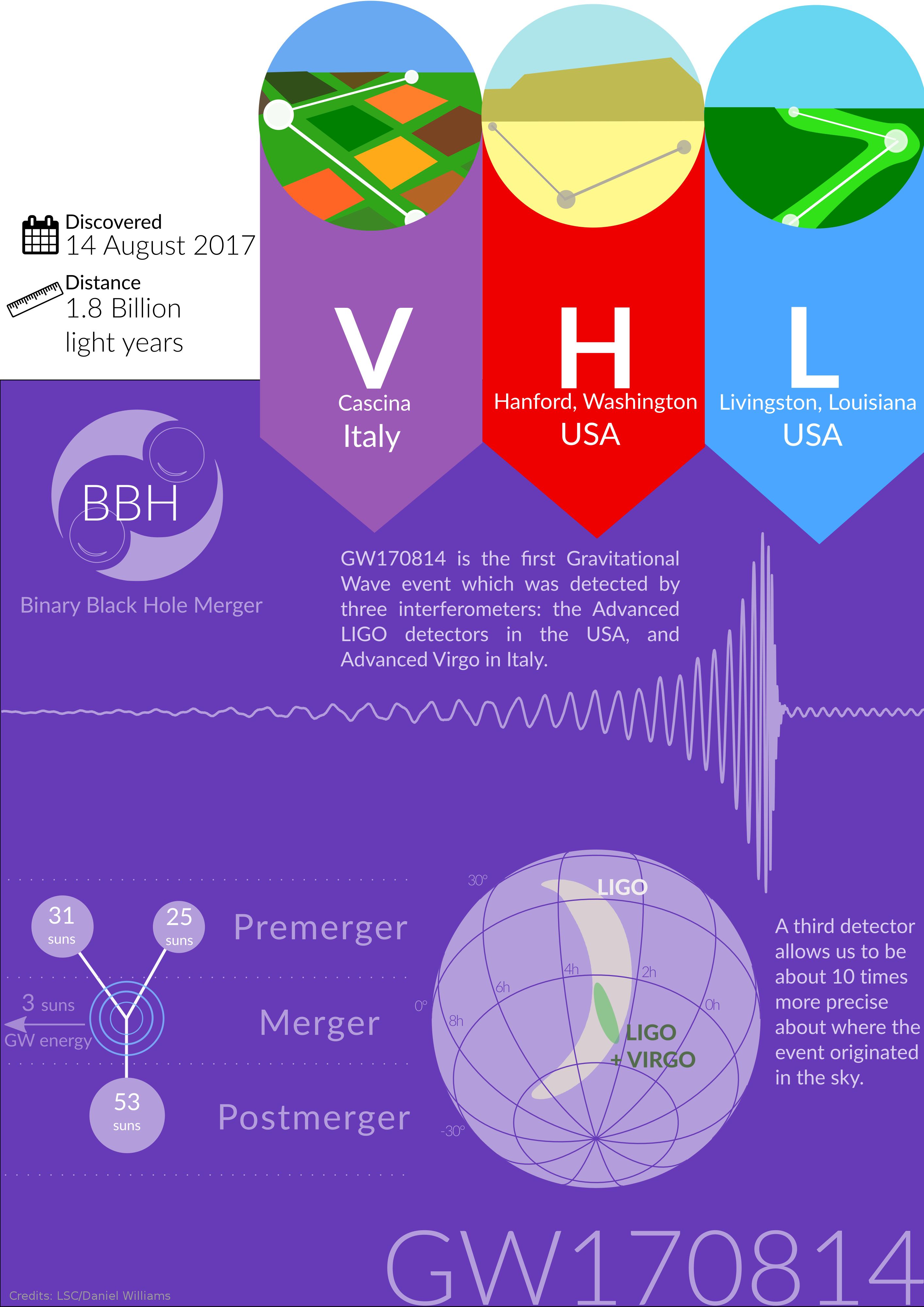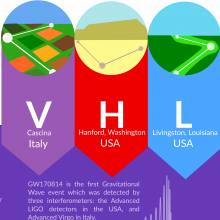The LIGO observatories in the USA observed the gravitational-wave signals from yet another merging black hole pair. This time, LIGO was joined by the Virgo observatory from Europe, which significantly contributed to the improved localization of this astronomical source in the sky, and enabled new tests of Einstein's theory based on the polarization of gravitational waves.
This event, detected on 14 August 2017, is the fourth detection of a merging binary black hole system. Three such events were detected by the twin LIGO detectors in the past (first two events in 2015 and the third one in January 2017). It is the first time that such a detection is being confirmed by a third detector. The Virgo detector started collecting data on 1 August 2017, and was soon bestowed with a detection, jointly with LIGO.
The signal was produced by the merger of two massive black holes, weighing 31 and 25 times the mass of the Sun at a distance of 1.7 billion light years away from us. An energy equivalent to the mass of three Suns was radiated as gravitational waves in this energetic astronomical event. These detections of gravitational waves from merging black hole pairs allow us to map out the distribution of black holes in the universe and to do precision tests of Einstein’s theory of General Relativity. Results from this detection are presented in a new paper accepted for publication in the journal Physical Review Letters.
 The LIGO-Virgo collaboration includes more than a thousand scientists from many different countries, setting a great example in international scientific cooperation. The recent publication has 40 authors from 13 Indian institutions. Over the last three decades, Indian scientists have done foundational work in various aspects of gravitational-wave science, including theoretical calculation of expected signals from astronomical sources, developing sophisticated data analysis techniques for searching weak gravitational-wave signals in noisy data and devising techniques to combine data from multiple detectors. The current Indian team in the LIGO-Virgo collaboration has made direct contributions to the extraction of the properties of the astronomical source from the data and to the first tests of Einstein’s theory using these observations. The Indian contribution to this emerging frontier will grow significantly in the future, with the materialization of the LIGO-India observatory, which is being built on Indian soil. This is expected to bring manyfold improvements to the source localization accuracy.
The LIGO-Virgo collaboration includes more than a thousand scientists from many different countries, setting a great example in international scientific cooperation. The recent publication has 40 authors from 13 Indian institutions. Over the last three decades, Indian scientists have done foundational work in various aspects of gravitational-wave science, including theoretical calculation of expected signals from astronomical sources, developing sophisticated data analysis techniques for searching weak gravitational-wave signals in noisy data and devising techniques to combine data from multiple detectors. The current Indian team in the LIGO-Virgo collaboration has made direct contributions to the extraction of the properties of the astronomical source from the data and to the first tests of Einstein’s theory using these observations. The Indian contribution to this emerging frontier will grow significantly in the future, with the materialization of the LIGO-India observatory, which is being built on Indian soil. This is expected to bring manyfold improvements to the source localization accuracy.
LIGO is funded by the NSF, and operated by Caltech and MIT, which conceived and built the project. Financial support for the Advanced LIGO project was led by NSF with Germany (Max Planck Society), the U.K. (Science and Technology Facilities Council) and Australia (Australian Research Council) making significant commitments and contributions to the project. More than 1,200 scientists from around the world participate in the effort through the LIGO Scientific Collaboration, which includes the GEO Collaboration. Additional partners are listed at http://ligo.org/partners.php. The Virgo collaboration consists of more than 280 physicists and engineers belonging to 20 different European research groups: six from Centre National de la Recherche Scientifique (CNRS) in France; eight from the Istituto Nazionale di Fisica Nucleare (INFN) in Italy; two in The Netherlands with Nikhef; the MTA Wigner RCP in Hungary; the POLGRAW group in Poland; Spain with the University of Valencia; and EGO, the laboratory hosting the Virgo detector near Pisa in Italy.
Media contact
Anupam Ghosh
International Centre for Theoretical Sciences, Tata Institute of Fundamental Research
Survey No. 151, Shivakote, Hesaraghatta Hobli, Bangalore North 560089, India.
Tel. 95917 32794 / 080 6730 6054 / 080 4653 6054
E-mail: anupam.ghosh @ icts . res . in


